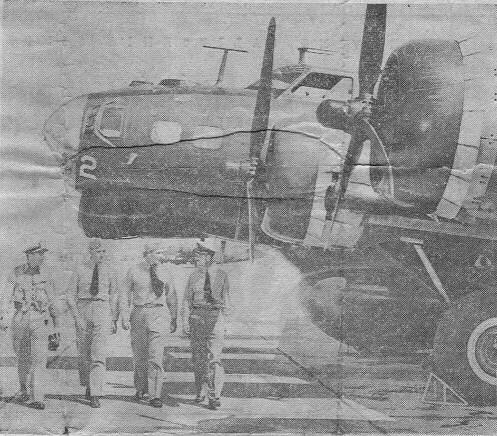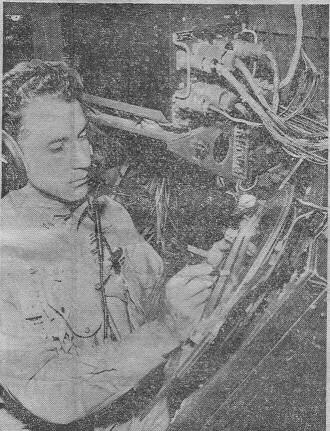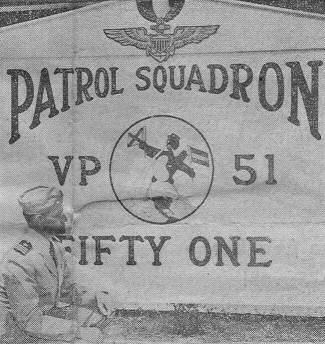Some of the most powerful military radar equipment in the world is hidden behind the belly bulges of modified B-17 Flying Fortresses the Navy is operating from Miramar Auxillary Air Station.
The planes belong to Patrol Squadron 51, whose airmen have gained the tag "Typhoon Chasers."
The nickname is one they don't especially cherish. The ability to play tag safely with a howling typhoon might stir pride in lesser aviators, but the pilots of PatRon 51 regard storm chasing as one of their minor chores, and the nickname is misleading -- it might give laymen a notion the squadron is composed of reckless, fly-happy zoomies.
 Bulging radome between wheels of Navy PB-1W, based at Miramar Auxilliary Air Station contains secret radar
equipment far more powerful than any used in World War II. Group of Patrol Squadron 51 officers includes,
left to right, Lt. C. C. McLean, Comdrs. F. P. Anderson and J. L. Mote, Lt.Comdr W. G. Maurer.
Bulging radome between wheels of Navy PB-1W, based at Miramar Auxilliary Air Station contains secret radar
equipment far more powerful than any used in World War II. Group of Patrol Squadron 51 officers includes,
left to right, Lt. C. C. McLean, Comdrs. F. P. Anderson and J. L. Mote, Lt.Comdr W. G. Maurer.
'HARDLEY DANGEROUS'
"They give us these jobs because no other outfit, Navy or Air Force has equipment like ours," Says Comdr. F. P. Anderson, executive officer and acting skipper of 51. "With our radar it's hardly even dangerous."
What this means is that the squadron's PB-1W's (Navy designation for the ex-B-17s) can stand off 100 miles or more from the heart of of the disturbance and tell precisely by radar where the whirling storm centers, what direction it is traveling, and how fast.
To observe conditions inside a typhoon it is necessary to fly through the worst atmospheric turmoil known to man -- where winds approach 150 knots, rain is torrential and there are vertical currents so violent that an aircraft may (if it isn't torn apart) be tossed a thousand feet skyward or seaward in a matter of seconds.
'RAIN INSIDE HEAVY'
It is the vertical currents that are dangerous. Under other conditions pilots could spot them by accompanying cloud formations and steer clear. Inside a typhoon however, visual piloting is almost useless. Often rain is so heavy the wingtips are invisible.
By piloting with its exquisitely precise radar, a PB-1W can pick its way between hot spots with the agility of a polo pony, reach to so-called "eye" of the typhoon or Hurricane, an area calm, clear air at the center -- and spiral down close to the surface to observe sea conditions.
Lt. C.C. Mclean, radar officer, is a "plank owner" in the squadron -- he was with the predecessor outfit organized at Quonset Point R.I. in 1946 as Aircraft Development Squadron 4.
'TRACKED HURRICANE'
He helped track the big Florida hurricane of 1947 (all the weather authorities labeled it non-dangerous until the Navy centered the storm in a radar scope and passed the word of its true size and course). McLean also spent several months in Guam and China last year with a PatRon detachment that tracked the western Pacific's big blows.
In a laudable effort to support Anderson's contention that typoon chasing isn't dangerous, McLean reported he could recall only two "incidents" while logging hundreds of hours at the radar scope.
Once his plane hit a down-current that instantly shifted him from his seat to a position against the overhead, injuring his head and shoulder.
 Whether PatRon 51 is chasing typhoons or submarines. Key post is that of the radar officer. Here Lt. McLean
spots distant targets on the master scope.
Whether PatRon 51 is chasing typhoons or submarines. Key post is that of the radar officer. Here Lt. McLean
spots distant targets on the master scope.
'DIDN'T SEE RUNWAY'
Another time his plane, piloted by Lt. Comdr. M. E. Herschi of Imperial Beach was forced by lack of fuel to land on Guam in a 60-mile crosswind in rain so heavy the runway couldn't be seen until the last seconds of the final approach.
He also recalled that a PB1-W flown by Lt. H. S. McDaniel flew into rain so thick the engines started to cough -- they were all but submerged in water at 8000 feet. McDaniel reversed course fast, thus living to bring back the report that typhoon chasing isn't dangerous.
Since PatRon 51 obviously spends most of its time in persuits other than tracking hurricanes, what is its military mission?
'OFFICERS SECRETIVE'
Squadron Officers properly are 100 percent mum of that point, but from general information already available on radar developments it is possible to reach several conclusions on the probable role of Miramar's PB-1W's if war came tomorrow.
One prime mission might be to serve as radar pickets -- this is evidenced by the interim designation. Early Warning Squadron 1, borne by the outfit when it arrived here from Quonset last year.
'RADAR LIMITED'
The radar "fence" Congress wants built around the continental United States would be of limited defensive value in modern war because of radar's line of-site limitations.
From sea level a fixed radar installation can't "see" a mile-high plane or a missile over the horizon until it is only 93 miles away. But a PB-1W could fly hundreds of miles to sea, scan the heavens hundreds of miles ahead and flash back information on course, speed and altitude.
The Navy admittedly has developed radar capable of coping in some degree with "snorkel" submarines, which need expose only the tip of a metal breathing tube. It is likely the PB-1W's belly radome (or built-in head-wind") houses advanced gear of this type.
The squadrons's insignia pictures an early bird with radome belly plucking a juicy worm fromthe Pacific -- and in anti-submarine warfare no worm is juicer than a snorkel.
 PatRon 51's insignia tells the story -- an early bird with radome belly plucks worm from Pacific. Signal
flags are"5" and "1"; Comdr. Anderson at left.
PatRon 51's insignia tells the story -- an early bird with radome belly plucks worm from Pacific. Signal
flags are"5" and "1"; Comdr. Anderson at left.
'LOST SHIP LOCATED'
As a search plane, in any event, the PB-1W performs jobs far exceeding anything possible with World War II radar. At Guam, for example the hull of the old battleship Oregon tore loose in a typhoon and disappeared at sea. When somebody decided 3 weeks later that the Navy ought to find her, a PatRon 51 plane did the job -- surveying more than 125,000 square miles of ocean and pinpointing the drifing hulk in a single sweep.
The Miramar craft also show obvious aptitude for C.I.C. (combat information center) applications, having radar and communications equipment that would enable them to evaluate constantly a changing tactical situation and co-ordinate the attack of either airborne or surface elements.
Skipper of PatRon 51 is Comdr. H. W. McDonald of 560 Rushville St. La Jolla currently on temporary duty in San Francisco. The squadron numbers 43 officers and 267 men.
